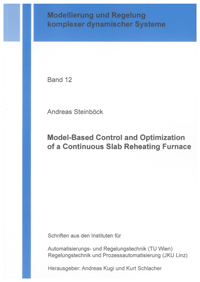
Shop : Details
Shop
Details

September 2011
Andreas Steinböck
Model-Based Control and Optimization of a Continuous Slab Reheating Furnace
Continuous reheating furnaces are used for reheating steel slabs before they can undergo some forming process. The slabs are arranged in rows and continuously conveyed through fuel-fired furnaces. As these furnaces are high-dimensional, nonlinear systems with only a few controllable inputs, their control is an intricate task. The situation is complicated by a lack of measurements, constraints on control inputs and process variables, an increasing diversity of products, rising demands in terms of product quality and throughput, synchronization requirements with other process steps, and the need for real-time operation. Moreover, the energy consumption, the emissions, and the operating costs should be minimized. This work thus aims at developing tailored control and optimization methods for a complex real-world problem.
A cascade control concept is proposed with a model-based MIMO furnace temperature controller and subordinate SISO controllers for regulating the fuel supplies to the burners. The underlying mathematical model uses the Galerkin method for solving the one-dimensional heat-conduction problem inside the slabs. The boundary conditions are defined by the radiative heat transfer in the furnace, and the controllable local furnace temperatures serve as model inputs. Due to the slab movement, the model is switched and its dimension may vary with time. It is discretized along the time domain and validated by measurements from an instrumented test slab.
The furnace may be operated with open-loop control, two-degrees-of-freedom control using a Lyapunov-based feedback law, or receding horizon control (model predictive control). Conditions for exponential stability of both open-loop control and two-degrees-of-freedom control are derived. Two alternative algorithms are proposed for model-based furnace temperature control: First, an iterative algorithm is developed, which plans and optimizes reheating trajectories by quadratic programming. Second, a constrained dynamic optimization problem with a finite optimization horizon is formulated and converted into an unconstrained problem by an input transformation and by adding penalty terms to the objective function. The unconstrained problem is numerically solved using the quasi-Newton method. This approach can also be used as a receding horizon controller, meaning that the optimization problem is recurrently solved for finite overlapping horizons. Both algorithms adequately account for constraints on control inputs and system states.
The proposed controllers are tested by simulations using a validated furnace model, which computes the energy flows inside the furnace as well as the temperatures of slabs, furnace walls, and flue gases. The simulation results demonstrate the feasibility of the control methods, the achieved reheating quality, and a significant potential for energy savings. Encouraged by these results, the controllers have been fruitfully implemented in the automation system of an industrial slab furnace. Compared to the previous control system, the new receding horizon controller reheats the slabs more accurately, reduces the operating costs, saves 9.7% of the energy consumption, and curbs CO2 emissions by more than 9500 t per year.
A cascade control concept is proposed with a model-based MIMO furnace temperature controller and subordinate SISO controllers for regulating the fuel supplies to the burners. The underlying mathematical model uses the Galerkin method for solving the one-dimensional heat-conduction problem inside the slabs. The boundary conditions are defined by the radiative heat transfer in the furnace, and the controllable local furnace temperatures serve as model inputs. Due to the slab movement, the model is switched and its dimension may vary with time. It is discretized along the time domain and validated by measurements from an instrumented test slab.
The furnace may be operated with open-loop control, two-degrees-of-freedom control using a Lyapunov-based feedback law, or receding horizon control (model predictive control). Conditions for exponential stability of both open-loop control and two-degrees-of-freedom control are derived. Two alternative algorithms are proposed for model-based furnace temperature control: First, an iterative algorithm is developed, which plans and optimizes reheating trajectories by quadratic programming. Second, a constrained dynamic optimization problem with a finite optimization horizon is formulated and converted into an unconstrained problem by an input transformation and by adding penalty terms to the objective function. The unconstrained problem is numerically solved using the quasi-Newton method. This approach can also be used as a receding horizon controller, meaning that the optimization problem is recurrently solved for finite overlapping horizons. Both algorithms adequately account for constraints on control inputs and system states.
The proposed controllers are tested by simulations using a validated furnace model, which computes the energy flows inside the furnace as well as the temperatures of slabs, furnace walls, and flue gases. The simulation results demonstrate the feasibility of the control methods, the achieved reheating quality, and a significant potential for energy savings. Encouraged by these results, the controllers have been fruitfully implemented in the automation system of an industrial slab furnace. Compared to the previous control system, the new receding horizon controller reheats the slabs more accurately, reduces the operating costs, saves 9.7% of the energy consumption, and curbs CO2 emissions by more than 9500 t per year.
Modellierung und Regelung komplexer dynamischer Systeme
Herausgegeben von Univ.-Prof. Dr. Andreas Kugi (TU Wien), o. Univ.-Prof. Dr. Kurt Schlacher (JKU Linz) und Prof. Dr.-Ing. Wolfgang Kemmetmüller (TU Wien), Wien / Linz
Band 12
Export bibliographischer Daten
Shaker Verlag GmbHAm Langen Graben 15a52353 Düren
Mo. - Do. 8:00 Uhr bis 16:00 UhrFr. 8:00 Uhr bis 15:00 Uhr
Kontaktieren Sie uns. Wir helfen Ihnen gerne weiter.

